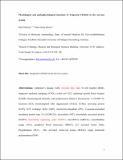Files in this item
Physiological and pathophysiological functions of Swiprosin-1/EFhd2 in the nervous system
Item metadata
| dc.contributor.author | Mielenz, Dirk | |
| dc.contributor.author | Gunn-Moore, Francis James | |
| dc.date.accessioned | 2017-08-11T23:33:31Z | |
| dc.date.available | 2017-08-11T23:33:31Z | |
| dc.date.issued | 2016-08-15 | |
| dc.identifier | 242357871 | |
| dc.identifier | 2d80741b-51de-47f3-89fb-3d3b263598a4 | |
| dc.identifier | 85010002048 | |
| dc.identifier | 000393715400001 | |
| dc.identifier.citation | Mielenz , D & Gunn-Moore , F J 2016 , ' Physiological and pathophysiological functions of Swiprosin-1/EFhd2 in the nervous system ' , Biochemical Journal , vol. 473 , no. 16 , pp. 2429-2437 . https://doi.org/10.1042/BCJ20160168 | en |
| dc.identifier.issn | 0264-6021 | |
| dc.identifier.uri | https://hdl.handle.net/10023/11436 | |
| dc.description | This work was supported by grants of the German Science Foundation (DFG, TRR130, to D.M.) and the Interdisciplinary Clinical Research Center Erlangen (E22, to D.M.); and to the Alzheimer’s Society UK (188, to F.G-M). | en |
| dc.description.abstract | Synaptic dysfunction and dysregulation of Ca2+ are linked to neurodegenerative processes and behavioural disorders. Our understanding of the causes and factors involved in behavioural disorders and neurodegeneration, especially Alzheimer's disease (AD), a tau-related disease, is on the one hand limited and on the other hand controversial. Here, we review recent data about the links between the Ca2+-binding EF-hand-containing cytoskeletal protein Swiprosin-1/EFhd2 and neurodegeneration. Specifically, we summarize the functional biochemical data obtained in vitro with the use of recombinant EFhd2 protein, and integrated them with in vivo data in order to interpret the emerging role of EFhd2 in synaptic plasticity and in the pathophysiology of neurodegenerative disorders, particularly involving the tauopathies. We also discuss its functions in actin remodelling through cofilin and small GTPases, thereby linking EFhd2, synapses and the actin cytoskeleton. Expression data and functional experiments in mice and in humans have led to the hypothesis that down-regulation of EFhd2, especially in the cortex, is involved in dementia. | |
| dc.format.extent | 3066565 | |
| dc.language.iso | eng | |
| dc.relation.ispartof | Biochemical Journal | en |
| dc.subject | Alzheimer's disease | en |
| dc.subject | Axonal transport | en |
| dc.subject | Cofilin | en |
| dc.subject | GTPase | en |
| dc.subject | Swiprosin-1/EFhd2 | en |
| dc.subject | Tauopathy | en |
| dc.subject | QD Chemistry | en |
| dc.subject | QH301 Biology | en |
| dc.subject.lcc | QD | en |
| dc.subject.lcc | QH301 | en |
| dc.title | Physiological and pathophysiological functions of Swiprosin-1/EFhd2 in the nervous system | en |
| dc.type | Journal item | en |
| dc.contributor.sponsor | Alzheimer's Society | en |
| dc.contributor.institution | University of St Andrews. School of Biology | en |
| dc.contributor.institution | University of St Andrews. Institute of Behavioural and Neural Sciences | en |
| dc.contributor.institution | University of St Andrews. Biomedical Sciences Research Complex | en |
| dc.identifier.doi | https://doi.org/10.1042/BCJ20160168 | |
| dc.description.status | Peer reviewed | en |
| dc.date.embargoedUntil | 2017-08-11 | |
| dc.identifier.grantnumber | 188 PG-2012-172 | en |
This item appears in the following Collection(s)
Items in the St Andrews Research Repository are protected by copyright, with all rights reserved, unless otherwise indicated.

